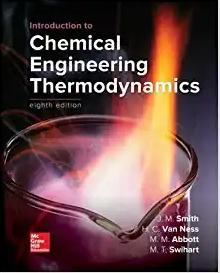Consider the heating of a house by a furnace, which serves as a heat source reservoir at
Question:
Consider the heating of a house by a furnace, which serves as a heat source reservoir at a high temperature TF. The house acts as a heat sink reservoir at temperature T, and heat |Q| must be added to the house during a particular time interval to maintain this temperature. Heat |Q| can of course be transferred directly from the furnace to the house, as is the usual practice. However, a third heat reservoir is readily available, namely, the surroundings at temperature Tσ, which can serve as another heat source, thus reducing the amount of heat required from the furnace. Given that TF = 810 K, T = 295 K, Tσ = 265 K, and |Q| = 1000 kJ, determine the minimum amount of heat |QF| which must be extracted from the heat-source reservoir (furnace) at TF. No other sources of energy are available.
Step by Step Answer:

Introduction To Chemical Engineering Thermodynamics
ISBN: 9781259696527
8th Edition
Authors: J.M. Smith, Hendrick Van Ness, Michael Abbott, Mark Swihart





